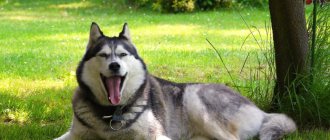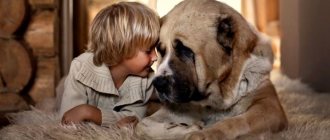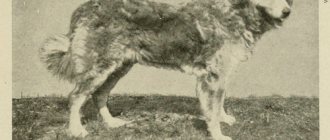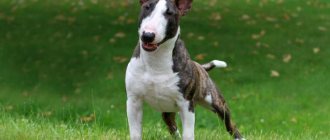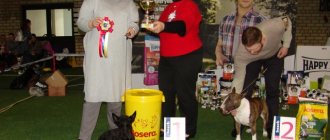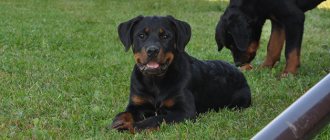Description and breed standard
The English Staffordshire Bull Terrier is a medium-sized, strong, stocky, well-balanced dog with well-developed muscles.
NOTE!
Representatives of this breed, despite their rather modest size, embody enormous physical strength and power, which, combined with low sensitivity to pain, makes them ideal fighting and hardy dogs.
Breed standard
:
- deep, wide, shortened head;
- short muzzle;
- wide jaws;
- scissor bite;
- the nose is large, the earlobe is black;
- eyes are medium in size, set wide, low, horizontally, the iris is dark or matches the color of the coat;
- ears are semi-erect or pink-shaped, not cropped;
- the body is muscular, heavy, but fit;
- the back is straight, the chest is deep, the neck is strong and wide;
- the tail is thick at the base, tapers towards the end, has medium length, and is set low;
- The paws are straight, set parallel and wide, the pads are round and small.
The coat of the Staff Bull Terrier is short, thick, close to the body, and the undercoat is short.
Pros and cons of the breed
The main advantages of the Staff Bull Terrier include:
- Strong physique. These dogs have a muscular build and fairly strong paws.
- Small stature. Despite the fact that these dogs were previously used for fighting, they do not grow to large sizes.
- Easy to care for. These bull terriers are easy to care for. They are unpretentious in food, and their coat does not require special care.
- Lack of aggression towards familiar people. Externally, representatives of this breed look quite aggressive. However, you really shouldn't be afraid of them, as they rarely show aggression.
Speaking about the disadvantages of Staffordshire Bull Terriers, we can highlight the following:
- aggressive attitude towards other animals;
- changeable mood;
- aggression towards unfamiliar people.
Additional Information. English Staffies can be aggressive in the first weeks after birth.
History of appearance
The ancestors of bull terriers were mastiff-like dogs, spread by the Romans throughout Europe. These animals were used as gladiators in the arenas in fights with bulls, lions and bears.
Mastiffs, despite their strength and power, were not suitable for fights because they were too clumsy and cumbersome, so in the county of Staffordshire, by crossing English bulldogs and Molossians, a new breed of dog was developed, the representatives of which were compact in size, speed and agility.
Over time, gladiator fights lost popularity and became prohibited, so breeding work was aimed at changing the temperament of these dogs and adapting them to life in the city. The breed received official recognition in 1939.
However, back in the 19th century. Staffordshire bull terriers and European dogs with similar features were exported to America, where there was no ban on dog fighting.
Breeders from the USA developed a new breed - pit bull terriers, which were distinguished not only by greater strength and endurance, but also by a higher level of aggression. These dogs were recognized in 1898 and given the name "American Staffordshire Terriers."
IMPORTANT!
Work to improve Amstaffs has led to their character becoming softer and more good-natured, which is a fundamental difference from pit bulls and staff bulls. This was the reason for the division of these dogs into separate breeds in 1936. Amstaffs were recognized by the FCI in 1972, English Staffordshire Terriers - in 1974.
History of the origin of the species
Bull Terriers are descended from mastiff-like dogs that the Romans spread throughout Europe. The animals were used as gladiators in the arenas and as baiters of bulls, lions and bears. The name “Bull Terrier” comes from the word “Bull” - from English “bull”. History of the origin of the species
Mastiffs were poorly suited for fighting; they were bulky and clumsy. A new light breed was developed in Staffordshire based on the English Bulldog and its Molossian ancestor. The dogs were distinguished by their compactness, speed and agility.
Over time, gladiator fights became too bloodthirsty entertainment for progressive people. The dogs' temperaments were changed for city life. The breed was officially recognized in 1939, after numerous exhibitions.
In the 19th century, Staffordshire Bull Terriers and similar European dogs were actively exported to America, where animal fighting was not yet prohibited. There, through active selection, a new breed was developed - the Pit Bull Terrier. She was more aggressive and muscular. She was recognized in 1898 by the American Club. A little later, the dogs were renamed American Staffordshire Terriers.
In the course of crossings and active work to improve their character, the pets became softer and more good-natured, unlike their Pit Bull brothers. Therefore, in 1936 the breed was divided, and in 1972 Amstaff was recognized by the international canine organization. Petes still remain unrecognized.
Character traits
English Staffordshire Bull Terriers have a difficult character.
They are brave, fearless, cheerful dogs, devoted to their owner and his family.
Representatives of this breed are smart and quick-witted and are easy to train. You need to start training your pet as early as possible, and you need to show him who is in charge and define the boundaries of what is permitted literally from the first days the puppy appears in the house.
Staffbulls always strive for victory and leadership, so it is necessary to make them understand that the “pack leader” is the owner, otherwise it will be impossible to achieve obedience.
Being energetic, strong and hardy animals, these dogs need regular exercise and active walks.
It is good if walking representatives of this breed includes not only walking or running, but also elements of training, as well as sports - agility, frisbee, weight-pulling. This helps not only release your pet’s energy, but also maintain its physical and mental health.
Staffbulls get along well with other pets, but only if they were raised together. The good attitude of these dogs does not apply to animals on the street or living in the neighborhood.
Their relationships with dogs, especially same-sex dogs, develop negatively. This is due to the desire of representatives of this breed for unconditional leadership and the spirit of battle that remains in them.
Expert opinion
Kozhevin Semyon Kirillovich
Expert dog handler.
English Staffordshire Bull Terriers are not a breed for everyone and certainly not for beginners. These dogs need owners who not only have experience in keeping and training dogs, but also self-confidence and the ability to be a leader. The authority of the owner must be undeniable - the staff bull must respect him and feel his superiority, only in this way will he obey and not become a threat to people.
Which breed is best suited for living in an apartment?
You can keep both pit bull terriers and Staffordshire terriers in an apartment or private house. Representatives of both breeds differ slightly in size, so they also require approximately the same space.
It is important to provide dogs with regular active walks and provide them with a personal place in the house with a moderately soft bed appropriate to their size, as well as a place for eating, where there should be bowls for food and clean drinking water.
Neither Staffords nor pit bulls are suitable for street keeping. Both of them cannot stand the cold and will freeze in winter even in a well-equipped enclosure.
IMPORTANT!
It is forbidden to put these dogs on a chain - such keeping contributes to the development of unmotivated aggression and problems with territorial behavior in them.
Differences from the American Staffordshire Terrier
Despite common roots, representatives of these breeds have significant differences:
- Staffbulls were bred in England, and Amstaffs were bred in the USA;
- Staffordshire Terriers are much larger and heavier;
- "American" ears can be cropped;
- Staff Bulls can get along with other pets that grew up with them; Amstaffs are too jealous and intolerant.
In addition, according to statistics, the difference in life expectancy between Staffbulls and Staff Terriers is 1-2 years in favor of the latter.
Who is easier to care for?
It is equally easy to care for both pit bulls and Staffords. Caring for these dogs does not require effort or special grooming and is a set of hygiene procedures that must be performed regularly.
So, these dogs need to be brushed with a brush with soft natural bristles or a special glove to get rid of dead hair and dust, as well as improve their blood circulation and bathe as needed, using shampoo according to their coat type.
It is also necessary to regularly brush your pet’s teeth to avoid the formation of plaque and stones, trim the claws as they grow, if they do not grind down on their own, and wipe the eyes and ears.
In addition, caring for representatives of these breeds involves regular deworming, treatment for external parasites and vaccination.
To maintain the physical and psychological health of Staffords and pit bulls, you need to walk them at least 2 times a day for 1 hour. Walks should be active and include elements of training, running, physical activity and games.
Advantages and disadvantages
The main advantage of Staffbulls, which everyone who sees these dogs first of all pays attention to, is their power and strength, which are combined with compact size and a certain aristocracy of the breed.
In addition, these dogs have the following advantages:
- friendly character;
- devotion;
- love for children;
- balanced psyche;
- high pain threshold;
- courage;
- high level of intelligence;
- ability to learn;
- absence of unmotivated aggression towards people.
Negative traits of this breed:
- the desire for leadership and the desire to show that they are stronger;
- poor relationships with other animals;
- stubbornness;
- year-round molting;
- intolerance of loneliness;
- the need for early socialization and competent education;
- need for regular active walks.
NOTE!
It should also be understood that Staffords, due to their compact size, are not suitable for use as home guards.
Brief history of origin
The purebred Staff Bull Terrier appeared in the first half of the sixteenth century. It received official recognition relatively recently - in the mid-thirties of the last century. His ancestors are mastiffs and bulldogs. It is worth noting that the bull terriers themselves gave rise to another fairly well-known breed - the American terriers.
For your information! Staffs are sometimes mistakenly called Staff Bull Terriers, a mispronunciation of the breed's name.
Dogs were used in different ways. Due to the fact that individuals of this breed have good agility and strength, they were bred to participate in dog fighting. Later, when such entertainment became less popular, dogs began to be used more often in the guard industry.
Important! Some people mistakenly call such a dog a fascist. However, in fact, the correct name for the breed is Staffordshire Bull Terrier.
Photos with examples of colors
The coat of representatives of this breed can be of the following color:
- red;
- red and white;
- fawn;
- white;
- black;
- black and white;
- blue.
In addition, a combination of any of these shades with white, as well as brindle and brindle-white colors, is acceptable.
Black and tan or liver colors are considered undesirable.
Staffordshire Terriers
Staffordshire Terriers are a breed of dog bred by breeders in the 30s. XX century based on pit bull terriers.
Photo and description
Staffies are stocky, hardy, proportionally built and muscular dogs, in which even at a quick glance one can see impressive strength, combined with mobility and elegance.
To meet the breed standard, these dogs must have:
- short back, with a slight slope from the withers to the croup, convex loin;
- deep, medium-length head;
- rounded muzzle with a pronounced under-eye area;
- large nose with well-opened nostrils and a black lobe;
- scissor bite;
- ears set high and wide;
- low and wide-set round eyes with dark irises;
- well defined withers;
- wide and deep chest;
- low set, straight and short tail.
The coat of representatives of this breed can have different colors. Most often there are individuals with fur of black, black and white, blue, and brindle colors.
Advantages and disadvantages
The advantages of these dogs include:
- intelligence;
- learning ability;
- endurance;
- fearlessness;
- easy care;
- lack of specific odor;
- ability to get along with children.
The disadvantages of the breed are that its representatives:
- stubborn;
- strive for dominance;
- cannot stand loneliness;
- need socialization and education.
IMPORTANT!
The disadvantage of Staffordshire terriers for many is their unsuitability for street and especially chain keeping.
Character traits
Staffordshire Terriers can be described as good-natured, sociable and inquisitive dogs, with a gentle and cheerful disposition. They are characterized by devotion to their owner and the need for his constant attention and care. These dogs cannot be ignored or kept alone - due to being in isolation, their character deteriorates, they become angry and unbalanced.
Representatives of this breed are not prone to displaying unreasonable aggression towards people; such behavior can only be the result of improper upbringing. Staffords' anger can only be directed at other dogs who, in their opinion, claim to be their leader.
Nutritional Features
Although Staffbulls are relatively small dogs, their food must be voluminous, high-quality and capable of replenishing large energy costs.
The diet can be based on both natural products and industrial feed; it is only important to ensure that the diet is balanced and contains everything necessary for the healthy growth and development of the dog.
With natural feeding, the pet’s menu should include:
- lean meat (beef, veal, poultry, horse meat);
- sea fish;
- eggs;
- fermented milk products (cottage cheese, kefir, fermented baked milk, natural yogurt);
- vegetables (carrots, red beets, pumpkin, cabbage);
- cereals (buckwheat, oatmeal, rice);
- greenery;
- fruits (except grapes, melons, citrus fruits);
- offal (liver, lung, heart, tripe).
Also, representatives of this breed should be given cartilage, hooves, ears and tails - their use helps strengthen the pet’s teeth and bones.
It is forbidden to feed staff bulls:
- fatty meat;
- tubular bones;
- milk;
- potatoes;
- fried, spicy foods;
- sweets, pickles, smoked meats;
- bakery, pasta and sausage products;
- onions and garlic;
- legumes
IMPORTANT!
It is necessary to monitor the quality of food, the volume of portions and follow the feeding regime, since these dogs are prone to obesity, which leads to unnecessary stress on the joints and heart.
The advantage of industrial feeds is their ease of use and balanced composition, enriched with essential vitamins and minerals.
Economy class food is not suitable for Staffy Bulls. The most suitable diets for representatives of this breed are produced by brands such as Bozita, Solid, Orijen, Genesis, Applaws, Acana, GO!, Grandorf.
Life expectancy and diseases
Despite their fairly good health and strong immunity, English Staffordshire Bull Terriers are insured against diseases.
The most common diseases among representatives of this breed include:
- cataract;
- heart diseases;
- hypothyroidism;
- deafness;
- urolithiasis disease;
- allergic reactions;
- luxation of the patella;
- bloating;
- dysplasia of the hip and elbow joints;
- entropion of the eyelid;
- hyperadrenocorticism;
- mast cell cancer;
- arthritis;
- brachycephaly;
- epilepsy.
The lifespan of staff bulls depends on many factors, including heredity and living conditions. On average, these dogs live 12-14 years.
Health and illness
A Staffordshire Bull Terrier puppy must undergo timely prevention and vaccination. Also, the dog’s health is affected by daily exercise.
A number of diseases to which the breed is predisposed:
- inversion of the eyelid or intestines;
- cataract;
- mast cell cancer;
- arthritis;
- urolithiasis disease;
- Cushing's syndrome.
Signs such as poor appetite, reluctance to move (the bull terrier simply lies in a dark place), and excessive drinking of water may indicate that your pet is unhealthy. Constipation, diarrhea, and frequent urination in your dog are also possible. Common symptoms that indicate health problems in the breed include:
- discharge of pus from the nose and eyes;
- blueness of mucous membranes;
- ruffled or faded fur.
If there are any signs, you should immediately contact your veterinarian.
Suitable for living in an apartment or outdoors?
Due to their compact size, dogs of this breed feel equally comfortable living in city apartments and private country houses. But at the same time, they need daily active walks lasting at least 2 hours.
Staffbulls are not suitable for outdoor living because their short coat does not protect them from the scorching sun and cold. In summer, they should be walked early in the morning or after sunset, and for walks in winter, the pet will need warm clothes.
Caring for a Staffbull
When caring for bull terriers, the following procedures must be followed:
- Combing. The fur of these dogs is quite short, and therefore it needs to be brushed no more than once a week. This is done with a special brush or comb.
- Bathing. Bath dogs as needed. When caring for a bull terrier, you need to do this at least once a month. During bathing, use special shampoos or conditioners for short hair.
- Dental care. To keep your pet's smile always pleasing to the eye, you need to periodically brush its teeth. They need to be cleaned of plaque 4-5 times a week.
Important! When brushing your teeth, you need to use a special toothpaste for dogs.
Bathing is one of the main dog care procedures
How are children treated?
Staffbulls get along well with children. These dogs are not inclined to show aggression towards people, and with children they behave calmly and treat them very kindly, becoming excellent nannies and friends.
However, children under 10 years old should not be left alone with a dog. At this age, kids still cannot control themselves and their unceremonious behavior can provoke an unwanted reaction from the staff bull.
Rules of care
These are short-haired dogs, so caring for them does not require much time and effort.
Wool and bathing
The Staff should be brushed weekly using a brush with natural bristles or a special rubber glove. Combing improves blood circulation, helps get rid of dead hairs and stimulates the growth of new ones.
Staffbulls need to be bathed once a month using shampoo for short-haired dogs. You need to wet the fur well with warm water, apply and foam the shampoo, and then rinse thoroughly, making sure that water and foam do not get into your pet’s ears.
The shampoo must first be diluted with water in a 1:1 ratio.
After washing, the dog must be thoroughly dried and combed.
Ears
The ears should be inspected weekly and accumulated wax and dust removed from them with a cotton pad soaked in warm water or a special lotion.
Teeth
To prevent the appearance of plaque and tartar, your dog’s teeth should be brushed 3-4 times a week using a special toothpaste and brush for dogs. You can also give your staffbull special treats that promote mechanical cleaning of the teeth.
Claws
In summer, claws usually wear down on the asphalt while walking. If this does not happen, and also in winter, they should be trimmed with a guillotine nail clipper every 2 weeks. Sharp ends should be smoothed with a nail file to avoid cracking.
To make the claws more pliable and easier to trim, the staffbull's paws should be soaked in warm water for several minutes beforehand.
Eyes
Every morning you need to remove the discharge that accumulates in the corners of the eyes with a clean, lint-free cloth soaked in boiled water or chamomile infusion.
Care and maintenance
Representatives of this companion breed do not require much space to live. Despite their super mobility, they do not cause much trouble to maintain. The main thing is to allocate a place with a soft pillow or bedding, give several toys: balls, squeakers, small ropes, rubber accessories. They will help to release energy, get rid of stress, and will also be useful in training.
Wool does not require special care, which is a big plus. During seasonal shedding in spring and autumn, dogs are well combed with brushes or special mittens with spikes. There is no need to carry out this procedure constantly.
Animals are usually bathed once every month. After water treatments, it is important to dry the fur well and wipe the paws dry. Once a day, you should pay attention to the eyes of Bull and Terriers, removing dirt and tear deposits from the corners. You can wipe with a cotton swab dipped in chamomile solution to prevent conjunctivitis. It is advisable to inspect the ears weekly, removing wax with a damp cotton pad.
Dogs' teeth require special attention. It is necessary to clean the mouth with a brush three times a week, and sometimes give special bones with mineral supplements to maintain the health of the cavity. It will be enough to carefully straighten the claws 1-2 times a month with scissors, then file them with a file. Before the dog pedicure procedure, you can steam the nail plate in warm water. This will make it easier to remove the keratinized part.
The basic rules for caring for and maintaining a Staffordshire Bull Terrier are simple and do not require grooming skills from the owner.
Training and education
| Team | Education |
| To me | After the puppy remembers its name, you need to call it, saying “Come to me!” It is better to do this when the pet is at a distance, but at the same time in the owner’s field of view |
| Near | In order for the dog to learn to walk near the owner’s left leg, without overtaking him or going to the side, you need to say the command and pull the leash, holding the staff bull |
| Sit/lie down | You need to show the puppy a treat, forcing him to raise his head and sit down, and lightly press on his croup. Teaching the “down” command is done in a similar way. |
| Place | Place the puppy in its place, say the command and begin to gradually move away, making sure that the pet does not follow |
How to choose a puppy?
You should not buy a puppy from someone else or from an advertisement. Only in a kennel can breeders guarantee the purity, health and balance of a dog.
NOTE!
It is best to buy a puppy when he is 2-3 months old - at this age the puppy will most easily cope with moving to a new home, and the new owner will independently develop his habits and character.
If a Staff Bull is purchased as a pet, you can opt for a pet-class puppy; to participate in breeding, you need a representative of the breeding class; if you have plans for a show career, you should purchase a show-class puppy.
Whatever class the future pet belongs to, it must be curious, active, playful, have no symptoms of pathologies (rash, scratching, dandruff, bloated belly, exhaustion, overweight) and developmental abnormalities, and meet the breed standard.
Price range
On average, Staffordshire Bull Terrier puppies cost 15-40 thousand rubles:
- a puppy without a pedigree can be bought for 15 thousand rubles;
- representative of the pet class - for 20-25 thousand rubles;
- a breed-class puppy will cost about 30 thousand rubles;
- for an elite show-class staff bull you need to pay at least 35 thousand rubles.
Price difference
There is also a certain difference in the cost of a pit bull terrier and a Staffordshire terrier.
Pit bull terrier puppies cost on average about 4-15 thousand rubles.
depending on the class to which they belong. In rare cases, if there is a pedigree and registration in international associations, the cost is approximately 25 thousand rubles.
A representative of the Staffordshire Terrier breed without vaccinations and documents can be bought for 6-9 thousand rubles, a puppy that has been vaccinated and has documents costs 8-20 thousand rubles, a show-class puppy will cost about 60 thousand rubles.

